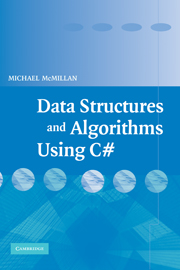Book contents
- Frontmatter
- Contents
- Preface
- Chapter 1 An Introduction to Collections, Generics, and the Timing Class
- Chapter 2 Arrays and ArrayLists
- Chapter 3 Basic Sorting Algorithms
- Chapter 4 Basic Searching Algorithms
- Chapter 5 Stacks and Queues
- Chapter 6 The BitArray Class
- Chapter 7 Strings, the String Class, and the StringBuilder Class
- Chapter 8 Pattern Matching and Text Processing
- Chapter 9 Building Dictionaries: The DictionaryBase Class and the SortedList Class
- Chapter 10 Hashing and the Hashtable Class
- Chapter 11 Linked Lists
- Chapter 12 Binary Trees and Binary Search Trees
- Chapter 13 Sets
- Chapter 14 Advanced Sorting Algorithms
- Chapter 15 Advanced Data Structures and Algorithms for Searching
- Chapter 16 Graphs and Graph Algorithms
- Chapter 17 Advanced Algorithms
- References
- Index
Chapter 14 - Advanced Sorting Algorithms
Published online by Cambridge University Press: 05 June 2012
- Frontmatter
- Contents
- Preface
- Chapter 1 An Introduction to Collections, Generics, and the Timing Class
- Chapter 2 Arrays and ArrayLists
- Chapter 3 Basic Sorting Algorithms
- Chapter 4 Basic Searching Algorithms
- Chapter 5 Stacks and Queues
- Chapter 6 The BitArray Class
- Chapter 7 Strings, the String Class, and the StringBuilder Class
- Chapter 8 Pattern Matching and Text Processing
- Chapter 9 Building Dictionaries: The DictionaryBase Class and the SortedList Class
- Chapter 10 Hashing and the Hashtable Class
- Chapter 11 Linked Lists
- Chapter 12 Binary Trees and Binary Search Trees
- Chapter 13 Sets
- Chapter 14 Advanced Sorting Algorithms
- Chapter 15 Advanced Data Structures and Algorithms for Searching
- Chapter 16 Graphs and Graph Algorithms
- Chapter 17 Advanced Algorithms
- References
- Index
Summary
In this chapter, we examine algorithms for sorting data that are more complex than the algorithms examined in Chapter 4. These algorithms are also more efficient, and one of them, the QuickSort algorithm, is generally considered to be the most efficient sort to use in most situations. The other sorting algorithms we'll examine are the ShellSort, the MergeSort, and the HeapSort.
To compare these advanced sorting algorithms, we'll first discuss how each of them is implemented, and in the exercises you will use the Timing class to determine the efficiency of these algorithms.
THE SHELLSORT ALGORITHM
The ShellSort algorithm is named after its inventor Donald Shell. This algorithm is fundamentally an improvement of the insertion sort. The key concept in this algorithm is that it compares items that are distant rather than adjacent items, as is done in the insertion sort. As the algorithm loops through the data set, the distance between each item decreases until at the end the algorithm is comparing items that are adjacent.
ShellSort sorts distant elements by using an increment sequence. The sequence must start with 1, but can then be incremented by any amount.
- Type
- Chapter
- Information
- Data Structures and Algorithms Using C# , pp. 249 - 262Publisher: Cambridge University PressPrint publication year: 2007

